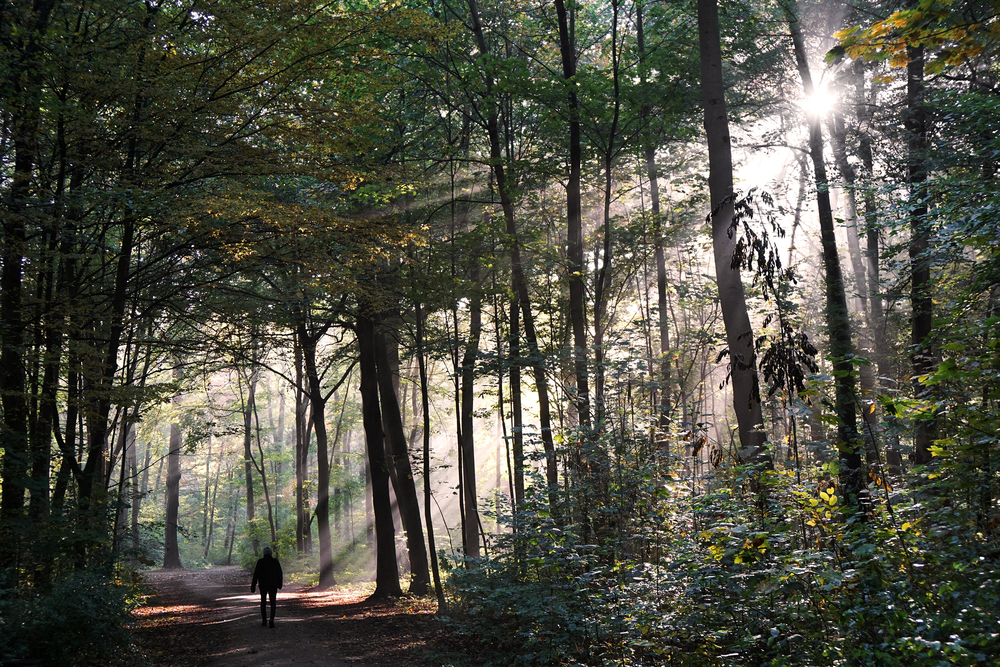“All my life through, the new sights of Nature made me rejoice like a child.” —Marie Curie
During England’s first lockdown in the spring of 2020, I took refuge in a wooded section of a park not far from my home for my daily, government-allowed exercise. Crisscrossing the extensive trails over several weeks, I watched hyacinth bulbs emerge from the ground, inch by inch, and burst into their heavenly scented, ruffled flower. As if in my own personal stop-motion film, I saw leaves unfurl from the trees above, bracingly green and brand new. I kept an eye on a mama duck perched on her nest near a small pond — rejoicing as she, one day, was joined by a brood of fluffy ducklings. Observing the natural world continue its uninterrupted march into springtime and rebirth, even as my life had seemingly ground to a halt, filled me with a deep sense of peace and perspective.
Though I didn’t know it at the time, I was, in fact, practicing the Japanese art of shinrin-yoku, or forest bathing.
In the 1980s, looking for a way to combat burnout amongst young workers, as well protect national forests, researchers in Japan found that time in nature lowered blood pressure, blood sugar, and cortisol (the “fight or flight” hormone), and increased focus, relaxation and concentration. Thus, shinrin (forest) yoku (bath) — forest bathing — was born. It’s proved such a success that it is now part of the national health program in Japan, and has been adopted by people all over the world. The simple practice of experiencing a forest — or any natural habitat — with all senses has profound physical and psychological benefits for the mind and body.
But what does it mean to bathe in a forest, and, more importantly, why should you?
To begin with, it may be helpful to point out what shinrin-yoku is not. It’s not exercise — at least not in the “feel the burn” definition. Your hike, walk, or jog is not the primary focus of the practice, though you will undoubtedly rack up points on your step counter. But rather than focusing on mileage, or heart rate, shinrin-yoku asks that you wander rather aimlessly — guided by your five senses: the sights, sounds, smells, and even things you are able to touch and taste along the way. You have no destination, nowhere to be, except exactly where you are. Savoring your time in nature with all of the senses available to you is the entire point. It’s an immersive experience to connect you with the natural world.
Experts say that a two-hour session is ideal to reap the full benefits of shinrin-yoku, but any amount of time will pay dividends in lower heart rate and blood pressure, increased relaxation, and crucially for many of us, time away from technology. Indeed, it may be easier for beginners to start with small chunks of time and build up to a full two hours.
I soon noticed that my walks in the woods afford me more solace than walks I took on city streets, even as empty as they were of the usual hustle and rush of “normal” London. That may well have been down to the oxygen rich atmosphere I was walking in amongst the trees. But it was also likely due to the aromatic compounds released by plants called phytoncides. These chemicals help trees fight off invaders like bacteria, fungi and harmful insects, and, when breathed in by humans, become important infection and inflammation fighters. Some researchers believe these powerful immune-system supporters can aid healing and even increase happiness.
Additionally, nature, in all its every-changing glory, provides a distraction that helps combat anxiety and depression. In pandemic times especially, it’s easy to get caught in a never-ending cycle of rumination, worry, and speculation. Shinrin-yoku frees up the mind for creativity and provides a link to something bigger than ourselves, allowing us to see how we slot into a larger picture.
Technically, and fortunately for those without ready access to green space, you don’t necessarily need to practice shinrin-yoku in a forest. You can take advantage of any natural environment — even your back patio — as long as you apply the principles of mindfulness: Slow down, turn off your tech, take big, deep, belly breaths, and notice how the outdoors makes you feel.
How to accomplish this? Be mindful. Listen: to birdsong, to the wind in the trees, to the scampering clatter of a squirrel’s tiny feet. See: the changing beauty of the natural world, the bright green awakening and blossom of spring, the lush exuberance of summer, the fiery blast of autumn, the naked sparkle of winter. Smell: the damp dirt, the tang and rot of the carpet of leaves, the freshness of the air after a rainstorm. Feel: the heaviness of the humidity in the air, the ground beneath your feet, the rough bark of a tree, the soft moss on a fallen log. Taste: the raindrops on your tongue, a sip from a clear stream (or, more realistically perhaps, a refreshing drink from your water bottle).
By tuning in to your five senses, you can expand what advocates of forest bathing call your sixth sense — a state of mind that encompasses equanimity, relaxation and joyful communion with nature. Twelve months and many miles later, as England emerges from another long national lockdown, I watch the magic of new life unfolding once again this spring. During a tumultuous and unsettling year, shinrin-yoku helped bring me back to myself, one step at a time.
Want to explore more?
- There are many books exploring shinrin-yoku in more detail. Dr Qing Li, an immunologist at Tokyo Medical School, is a well-respected physician and president of the Japanese Society of Forest Bathing. He authored Shinrin-Yoku: The Art and Science of Forest Bathing.
- In the UK, both the National Trust and Forestry England have thoughtful web pages devoted to forest bathing. The National Trust’s site includes a list of forests; Forestry England has 360-degree virtual forest tours for those unable to access green space in person.
- Japan Travel has an extensive list of national forests in which to practice shinrin-yoku in the country it was conceived.
- In the US, the Forest Service as well as many individual state websites, list forests to bathe in, from the Allegheny National Forest in Pennsylvania to the Olympic National Forest in Washington State.
By Stefin Kohn, Contributing Writer







